|
Getting your Trinity Audio player ready...
|
As technology advances, businesses constantly need to adapt and leverage technology to drive growth, efficiency, and collaboration. At the forefront of this revolution is B2B Software as a Service (SaaS), an innovative paradigm that has reshaped the software industry and redefined how organizations leverage critical tools and applications.
In this guide, we’ll dive into everything you want to know about Software as a Service, including B2B SaaS: definition, examples, and marketing strategies. By the end of this guide, you’ll be able to evaluate B2B SaaS software and choose the right SaaS solution for your business.
What Is Software As a Service (SaaS)?
Software as a Service (SaaS) is a software distribution model where you access software applications over the internet. Instead of downloading and installing software on your computer, you can use it through your web browser. It’s like streaming your favorite show without the hassle of downloads. Think of SaaS as the Netflix of the software world.
Here’re two real-world examples of SaaS:
Example 1: Dropbox
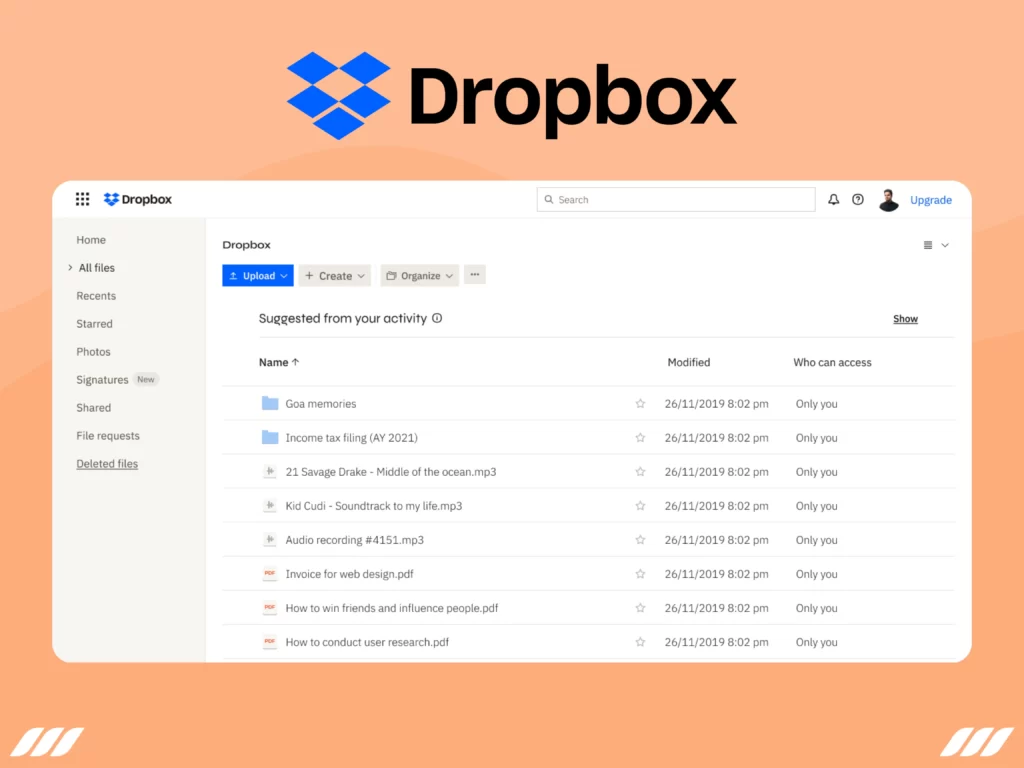
Dropbox is a popular cloud-based storage and file-sharing service that operates on the Software as a Service (SaaS) model. Users can store their files, images, graphics, and videos in the cloud and access them from any device with an internet connection. The service offers different subscription plans for individuals and businesses, providing scalable storage solutions that cater to a wide range of user needs.
Example 2: Salesforce
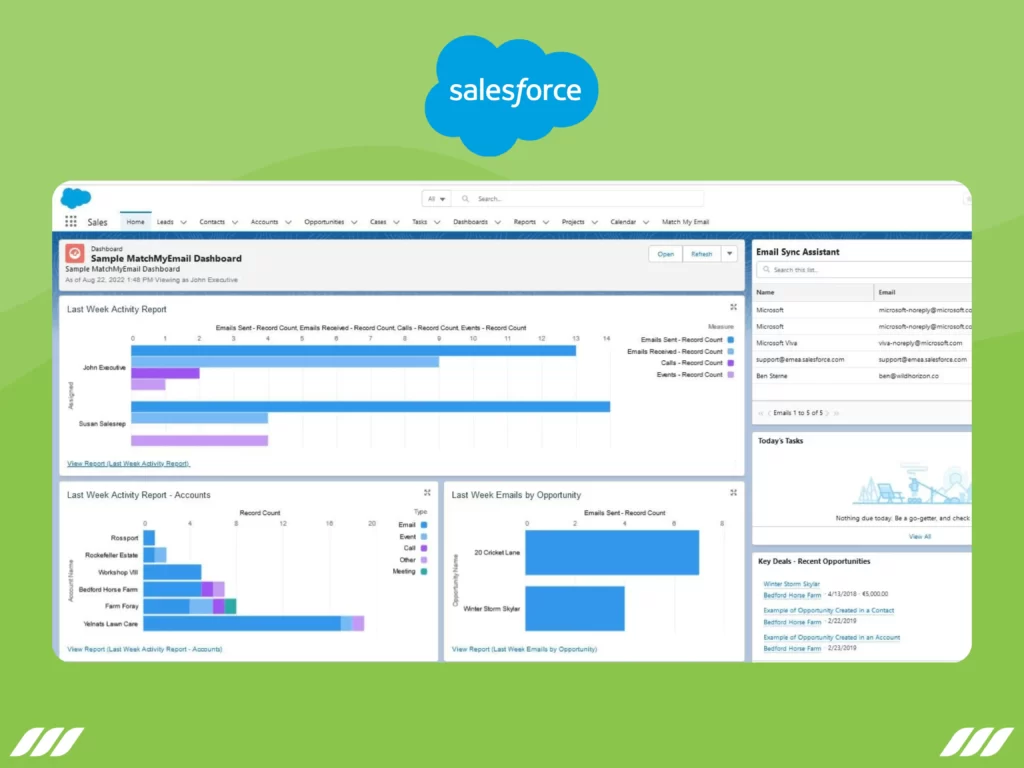
Salesforce is a leading CRM software offering a broad suite of cloud-based applications and services. As a SaaS provider, it helps businesses streamline their sales, marketing, customer service, and other vital operations into one cohesive platform. Users can access Salesforce’s CRM tools from any device, allowing them to track leads, manage customer interactions, automate sales processes, and analyze key business metrics.
What Is B2B SaaS?
B2B SaaS is about serving other businesses through Software as a Service. Instead of selling to individuals like in B2C SaaS, you’re catering to the needs of fellow businesses. B2B SaaS solutions help companies streamline operations, boost productivity, and scale their business. It’s like being the ultimate sidekick to businesses worldwide, supporting them on their growth journey.
B2B SaaS solutions often provide specialized tools and features tailored to specific industries or business functions. Project management software, customer relationship management (CRM) systems, and marketing automation platforms are all common examples of B2B SaaS applications. These solutions empower businesses to work smarter, collaborate efficiently, and drive growth.
Here’re two real-world examples of B2B SaaS:
Example 1: DocuSign
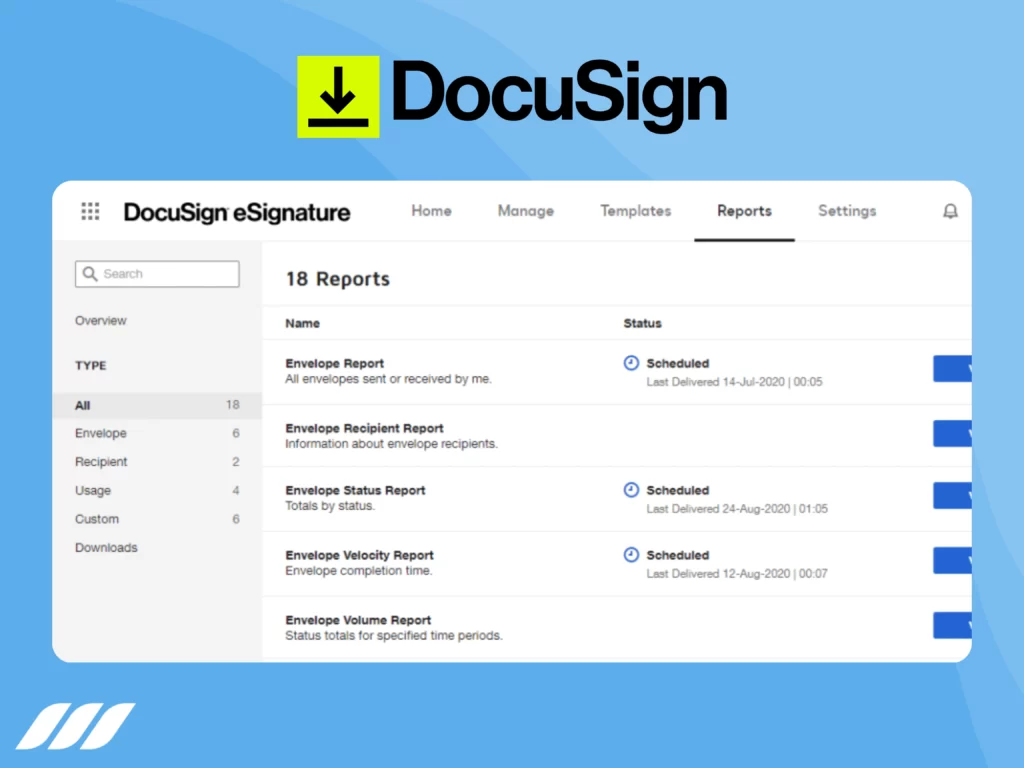
DocuSign is a B2B SaaS platform that offers electronic signature and contract management solutions. It allows businesses to send, sign, and manage important documents digitally.
Example 2: Monday.com
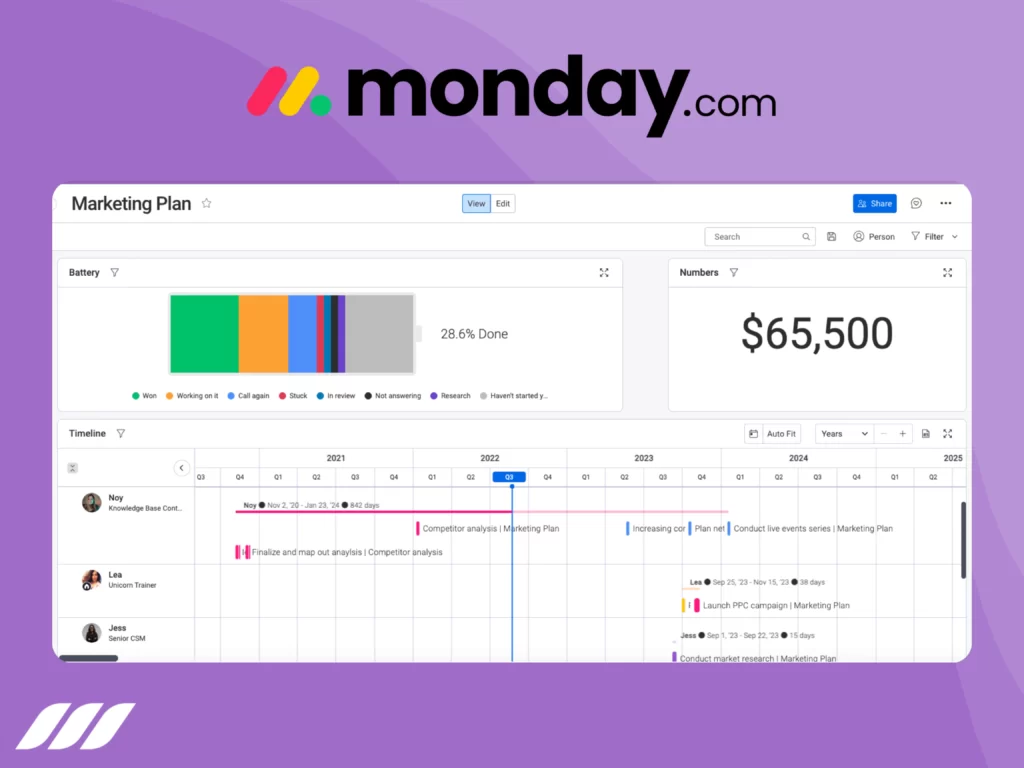
Monday.com is a B2B SaaS platform designed specifically for project management and collaboration. It has features you need to efficiently organize, track, and manage your work. It provides customizable project boards, task management features, team communication tools, and integrations with other business apps.

B2B SaaS vs. B2C SaaS
B2B SaaS and B2C SaaS may seem similar, but they have their differences.
B2B SaaS focuses on solving complex business problems, offering tailored solutions and advanced features to companies. Take the example of Dripify, a leading sales automation, and next-generation email marketing platform.
But why do you need Dripify for business? Well, Dripify is based on the Saas model, which means you’ll get access to rich features to automate your LinkedIn marketing activities and even email marketing. You can access the platform online from anywhere and on any device without requiring any software installation. You can tap into the tool’s powerful features, including AI, to spur business growth.
On the other hand, B2C SaaS targets individual consumers, providing user-friendly tools for personal use. Both have their charms, but B2B SaaS brings the big guns!
B2B SaaS customers have different needs and requirements compared to B2C customers. They seek solutions that integrate with existing systems, offer robust security measures, and provide scalability as their business grows. What’s more, B2B SaaS providers often offer dedicated customer support, customizations, and service-level agreements (SLAs) to ensure customer satisfaction and success.
Advantages and Disadvantages of SaaS
Now, let’s take a look at the advantages and disadvantages of the Software as a Service (SaaS) model. This analysis will help you make informed decisions about whether SaaS is the right fit for your business.
Advantages of SaaS
- Easy Accessibility: SaaS applications are accessed through a web browser, making them readily available from any device with an internet connection. You can work on your projects or access important data from the office, at home, or even while traveling. It’s like having your office in your pocket!
- Automatic Updates: Say goodbye to manual software updates! SaaS providers handle all the maintenance and updates, ensuring you always have access to the latest features and security patches. This means you’ll save time and resources that you can channel into other core business tasks.
- Lower Upfront Costs: Traditional software often requires significant upfront investments for licenses, infrastructure, and maintenance. In contrast, SaaS operates on a subscription-based model, where you pay an annual or monthly service charge. This eliminates the need for large upfront costs and enables more predictable budgeting. It’s like paying for the services you use rather than buying the entire store.
- Scalability: SaaS solutions are designed to scale with your business. As your organization grows, you can easily add more users or increase your subscription plan to accommodate higher demands.
- Flexibility in Pricing Models: SaaS providers offer multiple pricing options or plans, so you can easily choose the one that best suits your needs. Whether it’s a per-user pricing structure, tiered plans based on features, or customized enterprise solutions, you can align costs with your usage and business requirements.
Disadvantages of SaaS
- Internet Dependency: SaaS applications require a stable internet connection to function properly. If you experience internet outages or have a slow connection, it may hinder your ability to access and use the software. However, with the increasing availability of internet connectivity, this limitation is becoming less of a concern for many businesses.
- Data Security Concerns: Storing your sensitive business data in the cloud means relying on the security measures implemented by the SaaS provider. While reputable SaaS companies invest heavily in security protocols, there is always a slight inherent risk of data breaches or unauthorized access. It’s crucial to choose a trusted provider with robust security measures in place and regularly evaluate their security practices.
- Limited Customization: SaaS solutions are designed to cater to a broad range of customers, which means they may lack the level of customization that traditional on-premises software offers. While many SaaS providers offer configuration options, extensive customization may not be feasible. It’s a good idea to assess your specific business needs and evaluate the level of customization required before opting for a SaaS solution.
- Potential Vendor Lock-In: Once you commit to a specific SaaS provider, transitioning to a different provider or migrating your data can be challenging. This can create a sense of dependency on the provider and limit your flexibility. It’s essential to consider the long-term implications and thoroughly evaluate the provider’s reliability and compatibility with your business goals.
- Regulatory Compliance: Depending on your industry, certain regulations and compliance requirements may restrict the use of cloud-based solutions or impose additional security measures. As such, you should ensure that your chosen SaaS provider complies with relevant industry regulations and provides adequate security measures to meet your compliance needs.
Analyzing these pros and cons will help you determine whether a SaaS solution is the right fit for your business. Assess your specific requirements, consider the nature of your industry, and choose a SaaS solution that aligns with your goals and balances convenience, cost-effectiveness, and security.
Let’s weigh the pros and cons of the SaaS model. On the plus side, you enjoy easy accessibility, automatic updates, and lower upfront costs.
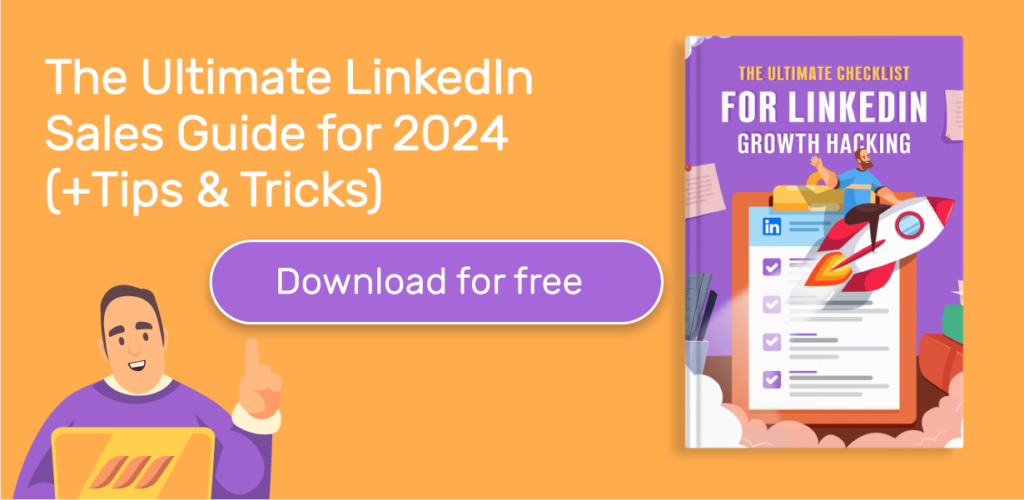

How to Do B2B SaaS Marketing
B2B SaaS marketing requires a strategic approach to effectively reach and engage your target audience. Let’s dive into some key marketing strategies and tactics that can help you drive awareness, generate leads, and convert prospects into loyal customers.
SEO (Search Engine Optimization)
SEO is a powerful long-term strategy to increase your SaaS platform or website’s visibility in search engine results and attract organic traffic. Optimizing your website for relevant keywords can help improve your search rankings and drive targeted traffic to your site.
- Conduct keyword research: SEO starts with keyword research. It is a good idea to search for keywords and phrases your target customers or leads will likely search for. You can use tools like Google Keyword Planner or SEMrush to find relevant keywords with high search volumes and low competition.
- On-page optimization: Optimize your website’s meta tags, headings, URLs, and content with target keywords. Plus, conduct SEO for LinkedIn by creating and sharing informative and engaging content that answers your audience’s questions and provides value.
- Content marketing: Develop a content marketing strategy that includes blog posts, articles, case studies, whitepapers, and e-books. These resources can help establish your brand as a thought leader and attract organic traffic to your website.
- Link building: Earn high-quality backlinks from reputable websites in your industry. Guest posting, partnerships, and outreach campaigns can help you secure backlinks, improving your website’s authority and search rankings.
Example: You have a company that offers SaaS-based project management software for marketing teams. Your SEO strategy could include creating content around topics like “effective project management for marketing campaigns,” “best project management tools for marketing teams,” and “how to streamline marketing project workflows.” When you optimize your website or platform for these keywords, it will help you rank higher in search results and attract marketing professionals looking for project management solutions.
Paid Ads
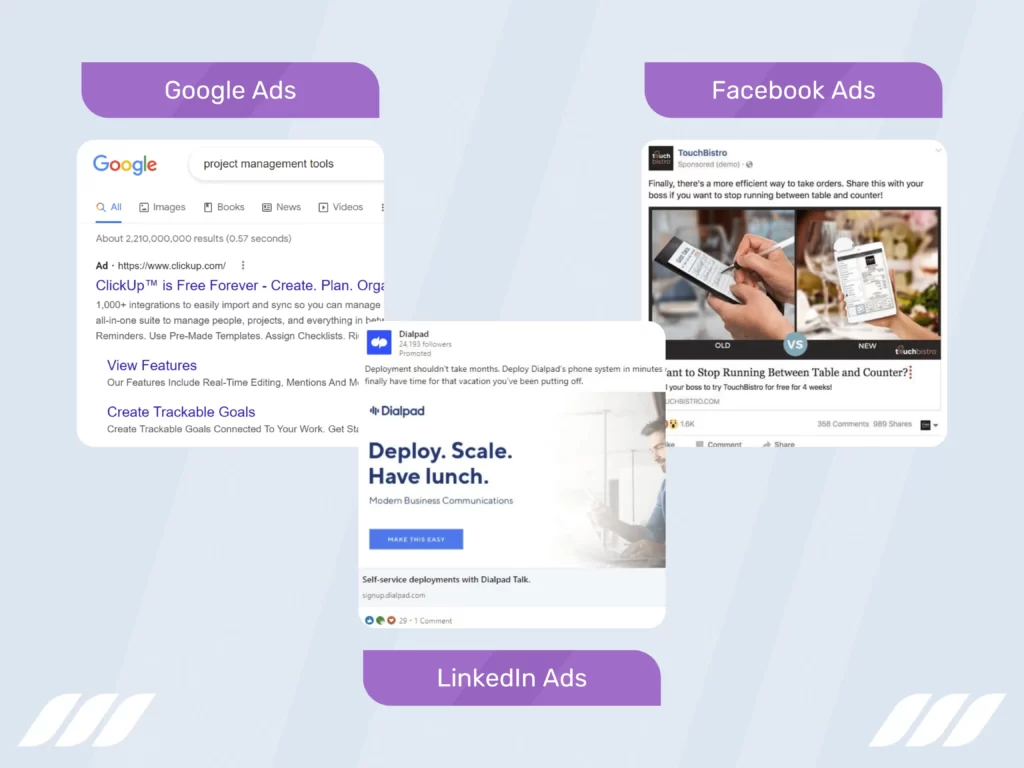

Paid ads are a great way to find leads and draw targeted traffic to your website quickly. Platforms like Google Ads, LinkedIn Ads, and Facebook Ads help deliver your message to your target audience based on factors like demographics, interests, and job titles.
- Google Ads: Create search ads that appear when your audience searches for relevant keywords related to your B2B SaaS offering. Display ads can also be used to raise brand awareness on websites within Google’s network.
- LinkedIn Ads: Leverage LinkedIn’s professional network to target decision-makers and professionals in specific industries or job roles. Sponsored content, sponsored InMail, and text ads can help you reach the right audience with personalized messages.
- Facebook Ads: Use Facebook’s robust targeting options to reach B2B professionals based on their interests, job titles, and behaviors. Create engaging ad creatives and compelling ad copy to capture attention and drive clicks.
Example: Say you offer SaaS CRM software for small businesses. With paid advertising, you can target small business owners or sales professionals actively looking for CRM solutions. You can use LinkedIn ads to create campaigns with compelling ad copy highlighting the benefits of your CRM software, such as increased productivity, improved customer relationships, and streamlined sales processes.
Email Marketing
It’s no secret that email marketing continues to be a highly effective strategy for nurturing leads, driving conversions, and building customer relationships. Here’s how you can use email marketing to promote your SaaS product.
- Use the best email marketing automation tools: Tap into the power of a top-notch email marketing automation platform to create targeted campaigns and promote your B2B SaaS solution. The right email marketing automation tool will allow you to automate workflows, deliver relevant content, and measure the success of your campaigns.
- Lead nurturing: Create automated email sequences to nurture leads at various stages of the buyer’s journey. Offer valuable resources, such as e-books, webinars, and case studies, to educate and build trust with your prospects.
- Promotional emails: Send targeted email campaigns to promote new features, special offers, or upgrades to your existing customers. Use persuasive copy and compelling visuals to encourage action and drive conversions.
- Personalization: Segment your email list based on criteria like industry, job role, or previous interactions. Then tailor your messaging and content to each segment, delivering a personalized experience that resonates with your audience.
Example: Let’s say you provide HR software for mid-sized companies. In your email campaigns, you can send personalized messages to HR managers highlighting the specific challenges they face, such as employee onboarding or performance management. Moreover, you can provide valuable content like HR guides, best practices, and success stories to nurture the leads and position your software as the ideal solution.
Social Media Marketing
Wondering what is social media marketing’s importance for B2B SaaS? Well, social media platforms offer a wealth of opportunities to engage with your target audience, build brand awareness, and drive website traffic. Identify the most relevant platforms to your audience and develop a social media strategy to engage and convert them.
- Content sharing: Share informative and engaging content, such as blog posts, videos, infographics, and industry news, on platforms like LinkedIn, Twitter, and Facebook. Also, encourage your audience to engage with your content, increasing your reach.
- Community building: Join relevant industry groups on platforms like LinkedIn and Facebook. Participate in discussions, answer questions, and establish yourself as an expert in your field. This helps build relationships and generates brand awareness.
- Influencer marketing: Partner with influencers in your niche or industry to amplify your brand reach and credibility. It is always good to identify influencers who have a relevant audience and work with them to promote your B2B SaaS offering through sponsored content, reviews, or co-created content.
Example: Suppose you offer collaboration software for remote teams. You can share tips and best practices for remote collaboration on platforms like LinkedIn and Twitter. Next, engage with your audience by asking questions, hosting Twitter chats, or sharing user-generated content that showcases how your software helps teams work together effectively.
By implementing these B2B SaaS marketing strategies, you can increase brand visibility, attract qualified leads, and ultimately drive growth for your business. Remember to monitor and analyze your performance to refine your strategies and optimize your results over time.




5 Best B2B SaaS Companies in the World
Now let’s meet the crème de la crème of B2B SaaS companies. These trailblazers are setting the bar high for innovation and success.
1. Google
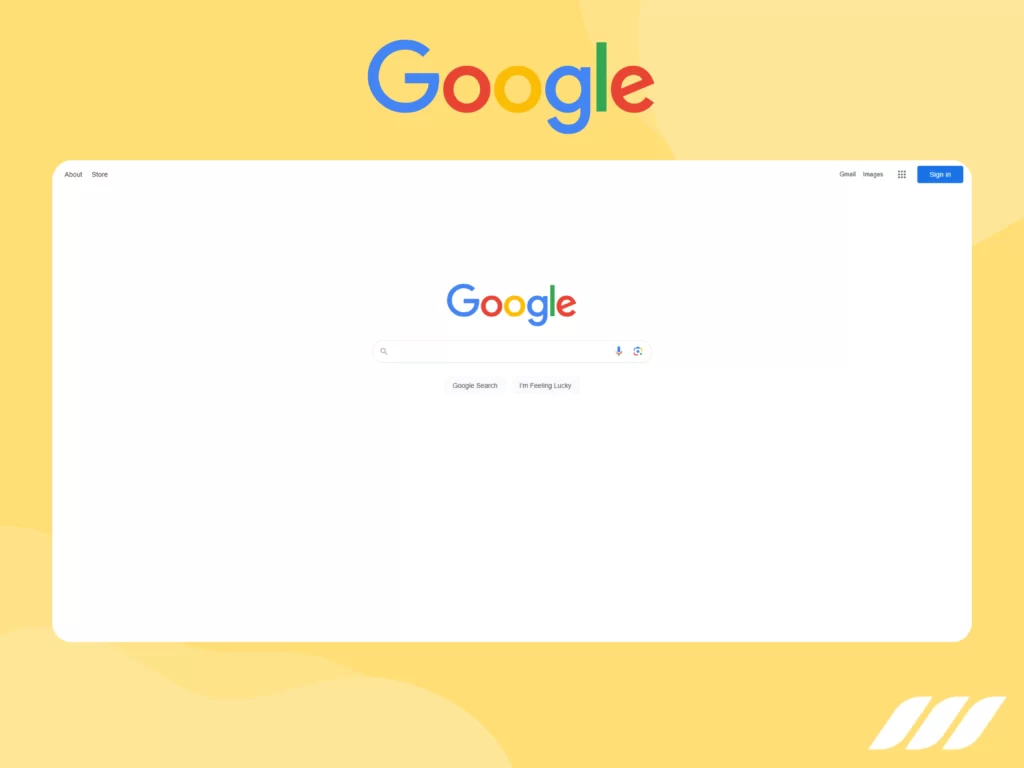

The tech giant needs no introduction. With a suite of SaaS products like Google Workspace and Google Cloud, they’ve got businesses covered from A to Z. Google Workspace offers productivity tools like Gmail, Google Docs, Sheets, and more, while Google Cloud provides infrastructure and data analytics solutions. Furthermore, Google Analytics provides powerful insights into website performance and user behavior, enabling businesses to optimize their digital strategies.
Case Study: Shopify, a leading e-commerce platform, leverages the Google Cloud Platform to handle its rapid growth and ensure reliable performance for its merchants. The scalable infrastructure provided by Google Cloud allows Shopify to handle high traffic volumes, provide seamless shopping experiences, and power its global network of online stores.
2. Microsoft Office 365


Microsoft’s SaaS offerings provide powerful collaboration tools, including Word, Excel, and Teams, making remote teamwork a breeze. Office 365 ensures seamless communication, file sharing, and project management for businesses of all sizes. With Office 365, businesses can enhance productivity, facilitate remote work, and collaborate seamlessly across teams and departments.
Case Study: GE Aviation, a leading provider of aircraft engines and systems, relies on Microsoft Office 365 to enable efficient collaboration and communication across its global workforce. The integration of tools like SharePoint and Teams allows GE Aviation employees to collaborate on projects, share documents, and communicate effectively, improving productivity and streamlining workflows.
3. Adobe
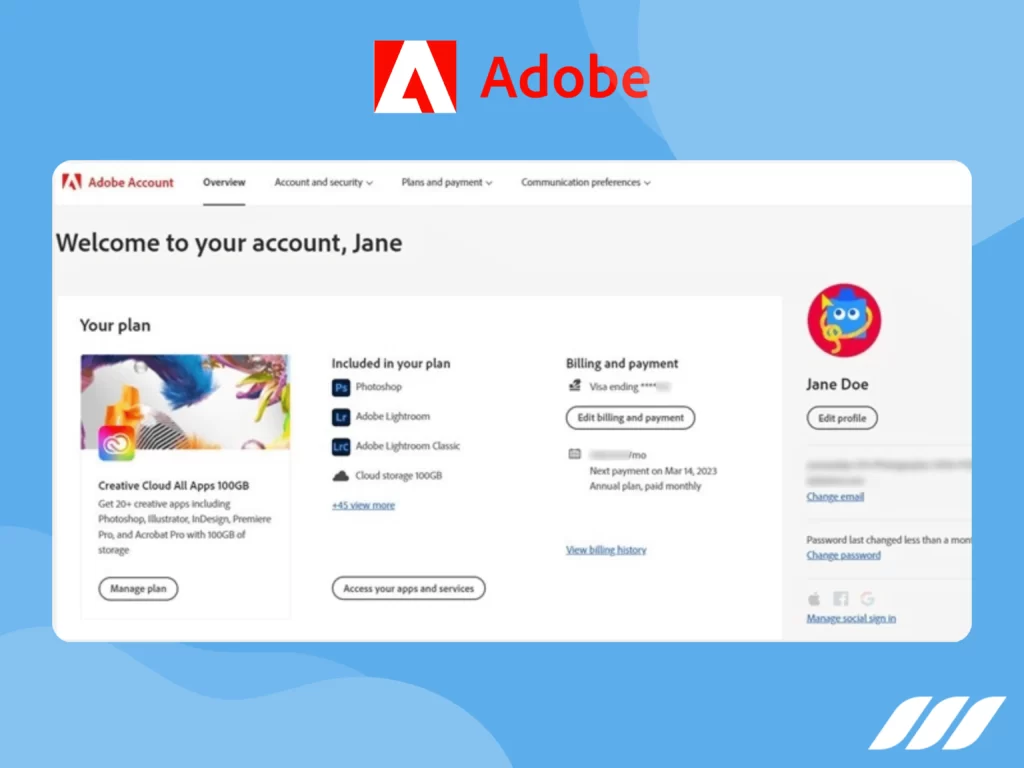

Creative minds unite! Adobe’s Creative Cloud gives businesses access to top-notch design and creative tools, empowering their creative genius. From Photoshop to Illustrator and InDesign, Adobe offers a comprehensive software suite for graphic design, video editing, and more. On top of these, Adobe Experience Cloud provides a comprehensive set of marketing solutions, including Adobe Analytics, Campaign, and Target, enabling businesses to deliver personalized and impactful customer experiences.
Case Study: U Mobile Malaysia successfully transformed its digital services into a mobile-first experience by leveraging the power of Adobe Experience Cloud. With a customer-centric approach, U Mobile used Adobe Experience Manager to create personalized and engaging content across multiple touchpoints, ensuring seamless experiences across devices. Also, Adobe Analytics provided valuable insights into customer behavior, enabling U Mobile to optimize its marketing strategies and drive business growth.
4. Slack
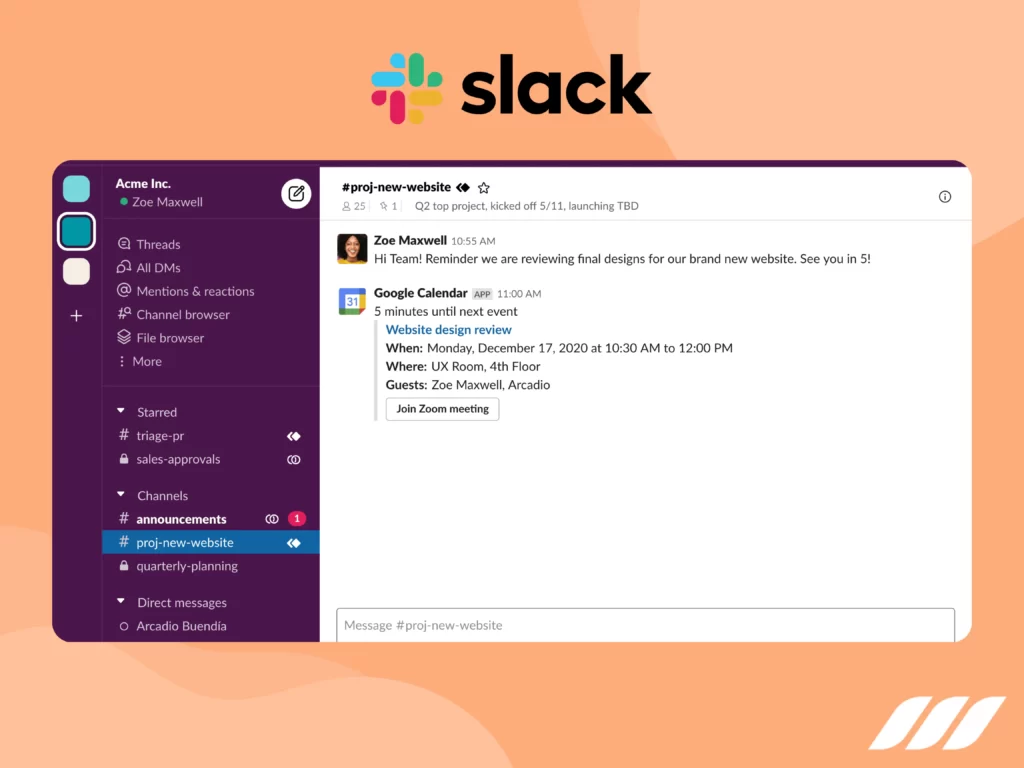

Slack has revolutionized workplace communication and collaboration with its intuitive team messaging platform. The SaaS platform allows teams to organize discussions into channels, share files, integrate with other tools, and collaborate in real-time. Its user-friendly interface and extensive integration capabilities have made it a go-to platform for teams to communicate, collaborate, and streamline their work processes.
Case Study: IBM adopted Slack as its primary communication and collaboration platform. By leveraging Slack’s features and integrations, IBM improved internal communication, enhanced team productivity, and fostered a culture of collaboration across its global workforce.
5. HubSpot


HubSpot offers a comprehensive suite of marketing, sales, and customer service tools. From CRM to marketing automation and content management, HubSpot provides an all-in-one solution for businesses looking to attract, engage, and delight their customers. HubSpot’s CRM allows businesses to manage customer relationships, track sales pipelines, and automate repetitive tasks. Its marketing automation tools enable businesses to create and optimize marketing campaigns, track leads, and measure performance.
Case Study: SurveyMonkey uses HubSpot to streamline its survey platform’s workflow. With the seamless integration between HubSpot and SurveyMonkey, users can now effortlessly send surveys directly from HubSpot and leverage SurveyMonkey data within the HubSpot platform. This integration enables users to segment and qualify contacts based on the valuable insights gathered from their survey responses.
Why B2B SaaS Is a Better Opportunity than B2C SaaS
When it comes to Software as a Service (SaaS), there are two primary target markets: business-to-business (B2B) and business-to-consumer (B2C). While both have their merits, B2B SaaS presents several advantages that make it a better opportunity for growth and success.
Let’s explore why B2B SaaS holds a competitive edge over B2C SaaS.
1. Larger Revenue Potential: B2B SaaS typically commands higher price points compared to B2C SaaS. More and more businesses are investing in software solutions to drive efficiency, productivity, and revenue growth.
This higher price point translates into greater revenue potential for B2B SaaS companies. Moreover, B2B SaaS often operates on a subscription-based model, ensuring a steady and recurring revenue stream.
2. Longer Customer Lifespan: In the B2B space, customer relationships are more long-term than B2C. Businesses consistently rely on software solutions to support their operations and processes over an extended period.
Once a business adopts a B2B SaaS solution and integrates it into its workflows, they are more likely to continue using it for an extended period. This longer customer lifespan provides stability, reduces churn, and fosters customer loyalty, leading to sustained revenue growth.
3. Reduced Customer Acquisition Costs: Acquiring B2B customers typically requires a targeted and strategic approach. While it may involve more complex B2B sales strategies, it often leads to higher customer lifetime value.
B2B SaaS companies can identify their ideal customer profiles, focus on specific industries or niches, and tailor their marketing and sales efforts accordingly. This targeted approach helps reduce customer acquisition costs by focusing on high-value prospects more likely to convert into long-term customers.
4. Upselling and Cross-Selling Opportunities: B2B SaaS companies have the advantage of upselling and cross-selling additional features, modules, or services to their existing customer base. As businesses grow and evolve, their software needs expand. B2B SaaS providers can capitalize on this by offering add-ons, premium features, or upgrades that cater to the evolving requirements of their customers.
5. Access to Valuable Customer Data: B2B SaaS companies have the opportunity to gather valuable insights and data from their business customers. This data can be used to analyze customer behavior, understand usage patterns, identify trends, and make data-driven decisions to improve the product, enhance user experience, and deliver more personalized solutions.
6. Long-Term Partnerships and Referrals: In the B2B space, successful partnerships and referrals play a significant role in driving growth. When a B2B SaaS solution proves valuable and delivers tangible benefits to a business, it often leads to positive word-of-mouth recommendations and referrals within the industry. Businesses trust the recommendations and experiences of their peers, which can result in a network effect for long-term partnerships.




Conclusion
Congratulations, you’ve now mastered everything you wanted to know about B2B SaaS! As you embark on your journey in the B2B SaaS landscape, remember to leverage the insights and strategies shared in this guide to drive growth, build strong customer relationships, and position your business for long-term success. Stay adaptable, embrace innovation, and continuously refine your marketing efforts to stay ahead in this competitive arena.
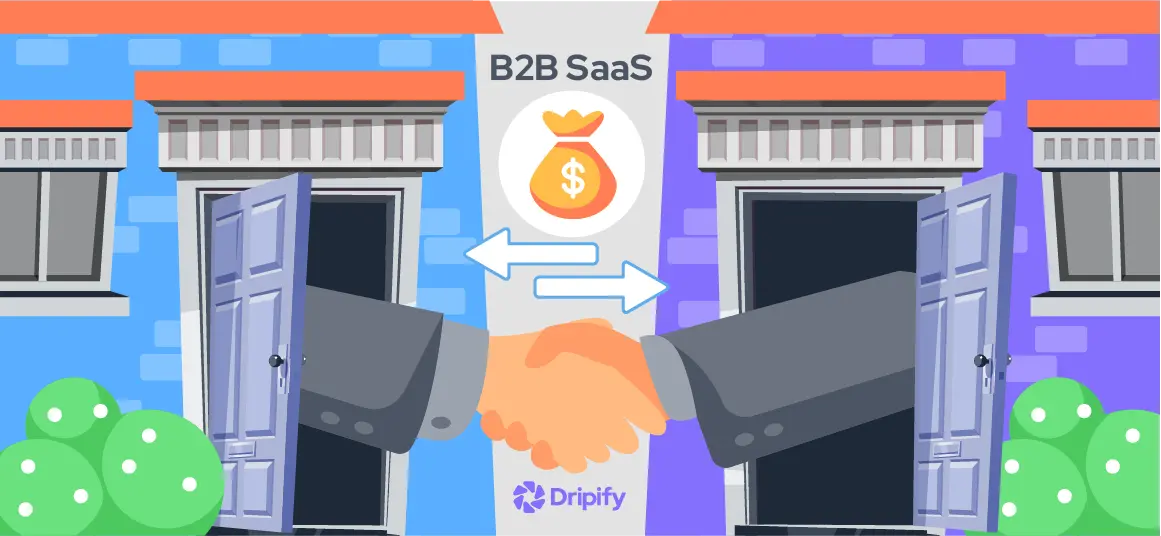
![How to Write a Price Increase Letter [Tips, Examples, and Free Template]](https://dripify.io/wp-content/uploads/2021/12/27.png)
![How to Write an Effective Collaboration Email [+Templates]](https://dripify.io/wp-content/uploads/2023/05/13.png)



